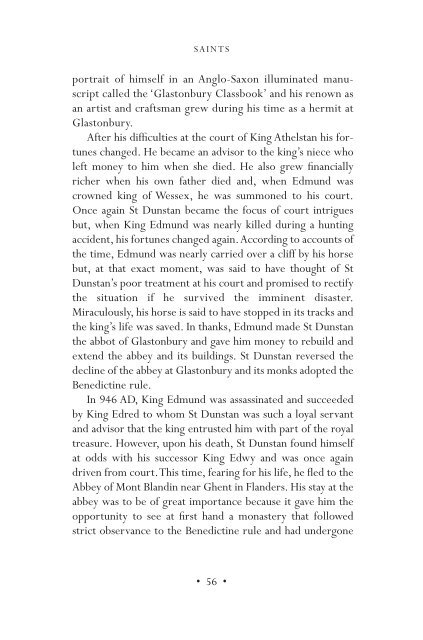02Knights Templar - Julian Emperor
02Knights Templar - Julian Emperor
02Knights Templar - Julian Emperor
You also want an ePaper? Increase the reach of your titles
YUMPU automatically turns print PDFs into web optimized ePapers that Google loves.
SAINTS<br />
portrait of himself in an Anglo-Saxon illuminated manuscript<br />
called the ‘Glastonbury Classbook’ and his renown as<br />
an artist and craftsman grew during his time as a hermit at<br />
Glastonbury.<br />
After his difficulties at the court of King Athelstan his fortunes<br />
changed. He became an advisor to the king’s niece who<br />
left money to him when she died. He also grew financially<br />
richer when his own father died and, when Edmund was<br />
crowned king of Wessex, he was summoned to his court.<br />
Once again St Dunstan became the focus of court intrigues<br />
but, when King Edmund was nearly killed during a hunting<br />
accident, his fortunes changed again.According to accounts of<br />
the time, Edmund was nearly carried over a cliff by his horse<br />
but, at that exact moment, was said to have thought of St<br />
Dunstan’s poor treatment at his court and promised to rectify<br />
the situation if he survived the imminent disaster.<br />
Miraculously, his horse is said to have stopped in its tracks and<br />
the king’s life was saved. In thanks, Edmund made St Dunstan<br />
the abbot of Glastonbury and gave him money to rebuild and<br />
extend the abbey and its buildings. St Dunstan reversed the<br />
decline of the abbey at Glastonbury and its monks adopted the<br />
Benedictine rule.<br />
In 946 AD, King Edmund was assassinated and succeeded<br />
by King Edred to whom St Dunstan was such a loyal servant<br />
and advisor that the king entrusted him with part of the royal<br />
treasure. However, upon his death, St Dunstan found himself<br />
at odds with his successor King Edwy and was once again<br />
driven from court.This time, fearing for his life, he fled to the<br />
Abbey of Mont Blandin near Ghent in Flanders. His stay at the<br />
abbey was to be of great importance because it gave him the<br />
opportunity to see at first hand a monastery that followed<br />
strict observance to the Benedictine rule and had undergone<br />
•56•













